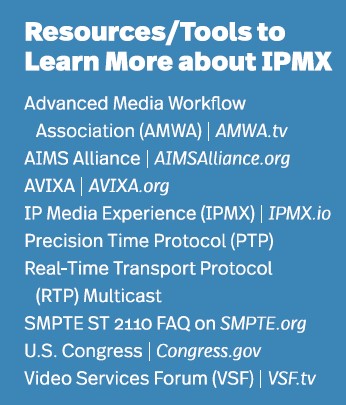AV-over-IP (AVoIP) has solidified its place as a staple in the pro AV industry, with adoption rates climbing steadily and no signs of slowing down, as reported in Commercial Integrator’s 2024 AV-over-IP Deep Dive Report.
When we spoke to Sean Wargo, vice president of market insights at AVIXA, for our 2024 report, AVoIP factored into nearly 50% of hardware revenues, reflecting already widespread deployment within integrators’ projects.
Wargo predicted a faster growth trajectory than the AV industry as a whole, foreseeing a healthy 5% to 6% compound annual growth rate (CAGR) for AVoIP from 2023 to 2028.
With such momentum, AVoIP is poised to become the primary transport solution driving pro AV installations. However, as multiple standards and protocols — like AES67, Dante AV, IPMX, SDVoE, and SMPTE ST 2110 — compete for dominance, the industry faces a pivotal moment to determine what will ultimately unify these technologies and define the future of AV connectivity.
Here, we explore the Internet Protocol Media Experience (IPMX), advocated by the Alliance for IP Media Solutions (AIMS). Drawing on insights from well-versed AV industry experts, we seek to paint a timely picture of the future of this burgeoning open standards-based technology.
We share perspectives from several thought leaders: Andrew Starks, AIMS Alliance marketing work group chair and director of product management, Macina America; Kevin Henneman, president, KMH Integration; Tim Kersting, chief design officer, CTI; Ian Cobb, senior IT systems architect, Alpha; and Ben Whitford, engineering manager, Mid Atlantic & Central, Diversified.
Related: Take a Short Survey on AV-Over-IP Technology
What is IPMX?
IPMX is an AVoIP technology that transmits high-quality audio and video such as 4K60p, as well as control signals over standard IP networks. Simply put, it is a common language that unites all audio and video on an IP-based network. It is designed to be generalized and flexible, supporting a wide range of use cases.
IPMX was developed through a collaboration between AIMS and the Joint Taskforce on Network Media (JT-NM), which brings together organizations like the Video Services Forum (VSF), the Advanced Media Workflow Association (AMWA), the European Broadcasting Union (EBU) and SMPTE.
These independent, non-profit groups are dedicated to creating open standards that are widely accessible. This ensures that IPMX remains free and open for anyone to adopt and use, reflecting a commitment to industry-wide accessibility and innovation.
Historical Context
Internet Protocol Media Experience may be new to some. However, it benefits from a well-tested and well-thought-out set of standards. Its core components have been in development and tested for over a decade.
IPMX builds on SMPTE ST 2110, which has been successfully used in live TV broadcasts, providing a proven track record.
“If you watch television, you will see video that passed through a SMPTE 2110 system,” explains Starks.
While the NMOS control pane and the ST 2110 transport layers have been around and tested for a while, there’s still an evolution for parts of it.
“We’re talking about an extremely well-tested set of standards,” emphasizes Starks.
IPMX represents the culmination of more than a decade of development, evolving from its broadcast origins to become a versatile and comprehensive solution for any AVoIP application.
Starks explains that, while IPMX incorporates the expertise and standards created within the broadcast industry, it has been specifically designed to meet the diverse needs of both pro AV and broadcast professionals.
By leveraging established IT technology, such as long-standing internet protocols and synchronization tools like precision time protocol (PTP), IPMX delivers a streamlined yet highly flexible system for transferring low-latency, high-quality video and audio over IP networks.
“[IPMX] addresses various use cases with upcoming support for codecs like high efficiency video coding (HEVC) for efficient compression, mezzanine codecs for pristine quality with subframe latency, and even uncompressed streams for industries like medical that demand the highest level of precision,” says Starks.
Additionally, it allows for synchronous and asynchronous timing, ensuring adaptability across a range of workflows. By providing a framework for interoperability and simplicity, IPMX enables devices to connect and operate on shared networks.

Proponents of IPMX believe it has the potential to fuel experiential solutions, serving the backbone for immersive technologies, real-time interactive content and create applications that blend AV & IT elements,. Courtesy / CTI
IPMX: Bridging AV and Broadcast for Seamless Workflows
Henneman says the convergence of AV and broadcast systems has been happening over the years, and he sees IPMX as the next logical step. The development of IPMX mirrors the transition from standard definition to high definition, when companies developed essential tools like up, down and cross converters to bridge the gap.
Similarly, IPMX is driving innovation, providing the tools needed to enable seamless video distribution and integration for clients.
KMH is in the process of testing and building out media workflows for a client using IPMX standards in its lab in New York. Although Henneman and his team can’t attest that IPMX is 100% perfect, he does know that, from what he’s seen from manufacturers, “it just makes sense.”
“If you have a camera and a switcher or a router or whatever downstream device, and its SDI-based, nobody thinks twice about it — it’s going to work,” he says. “You plug it in, connect the wire, turn it on and it’s going to work — and that is what IPMX is supposed to be able to do for our IP audio and video over IP workflows.”
“By uniting traditional AV and broadcast technologies, it ensures connectivity and smooth integration across devices. To me, IPMX is the common language that will allow the end user to be able to mix the integration aspects of broadcast and AV, and, in theory, be able to do it seamlessly,” says Henneman.
Similarly, Kersting is excited about what IPMX can do for how their firm designs and deploy systems.
“[IPMX] works across manufacturers, so you’re not locked into one brand or product line ecosystem,” he explains. “That’s a big deal for our us and our clients. It means we can focus on creating solutions that solve problems and meet the unique needs of each project, not trying to force a round peg into a square hole.
“IPMX will give us the freedom to think beyond hardware limitations and build systems that just work, no matter the setup,” says Kersting.
IPMX: Breaking Barriers to Interoperability for Scalable, Flexible AV Solutions
Cobb has been following the development of IPMX since it was announced at ISE in Amsterdam in 2020. He highlights a key challenge in the pro AV space — proprietary IP-based video transport technologies have created isolated systems that limit interoperability.
During COVID-19, supply chain disruptions underscored the risks of relying on single vendors, as obtaining necessary equipment became difficult.
“These ‘walled gardens’ work well individually but exchanging video between systems often requires cumbersome conversion processes,” explains Cobb.
IPMX delivers a non-proprietary standard for pro AV video solutions, enabling interoperability between manufacturers and offering the freedom to mix and match products like encoders and decoders.
Its flexibility supports diverse workflows, including HDMI-based presentation systems and live production environments, making it a versatile solution for varied customer needs.
By reducing technical barriers, IPMX empowers AV integrators to focus less on bridging technology gaps and more on delivering creative, scalable solutions.
Additionally, its open standards transport and control plane, combined with a web API, enable vendors to customize and extend IPMX for innovative applications, enhancing integration capabilities and driving greater efficiency throughout customer workflows.
The Business Case for IPMX
“There’s nothing about IPMX that stops it from being usable, really, in any, scenario — it’s very flexible,” adds Starks. It is uniquely positioned to support diverse AVoIP applications, such as those on college campuses with stadiums, classrooms and digital signage.
Its design prioritizes accessibility, ease of use and flexibility by leveraging technologies that are software-friendly, reducing costs and simplifying implementation across various environments.
By integrating with existing hardware, like PTZ cameras, and using an open standard that fosters industry convergence, IPMX is expected to drive significant cost efficiencies over time, creating scalable and economical solutions for a wide range of AV needs.
IPMX opens the doors for end users to scale very easily. Additionally, it’s open standard enables seamless integration between AV and high-end production environments.
It simplifies workflows, making it easier to connect conference rooms with advanced studios, and is gaining strong support from manufacturers with new products on the horizon.

According to proponents, IPMX will provide integrators the freedom to think beyond limitations and build systems that just work, no matter the setup. Photo by Museum of Art + Light, courtesy of Diversified.
IPMX’s Potential
IPMX aims to bridge the gap between SMPTE 2110 and AVoIP protocols like NDI and Dante, creating a unified language. Once fully established, it has the potential to transform how the industry approaches IP-based workflows.
Kersting highlights its immediate impact, stating, “The biggest business drivers right now are the ability to connect devices in more complex systems and the interoperability with SMPTE standards. As more vendors adopt IPMX, the options to use it for solving problems will keep growing.”
Adding to this, Cobb emphasizes the opportunities for integrating robust hardware and software into workflow. “With continued development and manufacturer support, we’re going to not only see new great hardware-based technologies and functionality, but we’re also going to see a lot of new, really great software that allows us to bring all of the stuff full circle,” he explains.
Kersting echoes this sentiment, reiterating the value of widespread adoption. “As more manufacturers adopt the standard, it’s going to open up even more possibilities for integrators. For complex system designs, IPMX gives us options that just weren’t available with older IP-based AV technology,” he notes.
This accessibility promises to expand the boundaries of system design, offering integrators tools they may not have had before.
With so much potential, we turned to Whitford to explore the opportunities IPMX could unlock for large-scale integrators like his firm.
His response was undeniably optimistic and forward-looking:
- More ambitious projects: With fewer concerns about mixing various AV platforms, we can propose larger, more sophisticated solutions with confidence.
- Enhanced remote monitoring/management: A standardized protocol can streamline remote support, diagnostics, and updates, saving time and cutting costs for both integrators and end clients.
- Innovative service offerings: IPMX could pave the way for new managed services — like cloud-based control, analytics, or cross-campus AV routing—since integrating different systems would be more straightforward.
- Global consistency: For integrators operating across multiple regions, IPMX can unify design standards, making it easier to deploy similar AV infrastructures worldwide.
IPMX has the potential to revolutionize the landscape for integrators and unlock opportunities on multiple fronts.
IPMX simplifies AV and broadcast system integration over a network, reducing technical hurdles and ensuring seamless workflows.
This empowers integrators to better assist customers in navigating complex needs, such as digital distribution and emerging technologies, while leveraging extensive industry experience to deliver customized solutions.
Positioning for Long-Term Success
 If you’re not familiar with IPMX yet, now is the time to start exploring it. All interviewees emphasize the value of getting ahead and gaining an early-mover advantage.
If you’re not familiar with IPMX yet, now is the time to start exploring it. All interviewees emphasize the value of getting ahead and gaining an early-mover advantage.
Whitford underscores this by saying, “By understanding the standard and experimenting with pilot deployments, integrators can proactively shape offerings that resonate with clients who demand future-proof, flexible solutions.”
The opportunity lies in learning and adapting before the standard becomes widespread.
To start, Kersting suggests tapping into resources like AIMS for a solid foundation.
“Start with AIMS, it’s a great resource for understanding the basics. From there, you can reach out to individual manufacturers for information on specific products and services,” he recommends.
Adding to this, Starks identifies key technical areas to focus on, including NMOS, SMPTE 2110 and PTP.
“You don’t need PTP in every situation, but there are situations where you’re going to want it, especially when you’re interoperating with AES67 which, is part of IPMX,” he explains.
He further highlights AIMS’ commitment to providing comprehensive training programs, making it easier for integrators to develop expertise.
“Now is the perfect time to get acquainted with IPMX,” he adds.
Henneman stresses that adapting to IP-based workflows involves more than just technical knowledge; it requires building strategic relationships with manufacturers and honing new skills.
“Building relationships with emerging manufacturers, bolstering your team’s IP expertise, and collaborating with key switch providers like Cisco and NETGEAR AV are crucial steps,” he says.
This shift also requires a new approach to troubleshooting, moving from baseband analytics to network-based error detection. Engineering teams need to focus on certifications and training in these new protocols to excel in this evolving space, he emphasizes.
Taken together, these insights underline the importance of gaining practical experience with IPMX alongside knowledge. Understanding the standards and building partnerships are crucial, but hands-on experimentation can take that understanding to the next level.
Cobb reinforces this idea, advising, “Go get a couple of boxes and start playing with it. Learn how it works.”
For those not currently working with broadcast solutions, this deeper engagement with IPMX can unlock new opportunities.
“It’s a forward-thinking approach to distributing IP video across corporate, enterprise and educational environments,” he adds.
IPMX Nears Maturity
Starks reinforces that the mission of AIMS is to ensure IPMX evolves with market demands while remaining a versatile, interoperable standard.
“With core standards established and testing underway…we’re in the final stages,” he shares.
Over the past four years, IPMX has achieved significant progress, advancing at an impressive pace compared to typical industry standard timelines.
The AIMS Alliance urges integrators to actively shape IPMX’s future by engaging with organizations like AIMS, AMWA, VSF and SMPTE. Starks highlights the critical role of user collaboration in refining IPMX into a globally reliable standard.
“Creating a system that works seamlessly across cultures and regions requires ongoing teamwork and precision,” he explains.
By sharing insights and addressing challenges, integrators not only contribute to IPMX’s evolution but also build confidence in its adaptability and performance.
As IPMX approaches maturity, its impact on the pro AV industry could be transformational, establishing itself as the universal standard for AV distribution.
Much like how IP standards reshaped telecommunications and streaming, IPMX promises to simplify and unify workflows across broadcast and pro AV, eliminating many of the interoperability challenges that have long hindered integration.
This advancement would enable firms to shift their focus toward enhancing user experiences, creating systems that are not only efficient but also highly innovative.
With IPMX, hybrid work and learning environments could benefit from standardized streaming and collaboration tools, while clients might see reduced costs through modular, easier-to-upgrade systems.
Perhaps most exciting is its potential to fuel experiential solutions, serving as a robust backbone for immersive technologies, real-time interactive content, and creative applications that blend audio, video and IT elements.
Redefining Commercial AV
“IPMX isn’t just about technology,” says Whitford. “It’s an industry movement driven by collaboration between manufacturers, integrators and standards bodies. We encourage continued dialogue and testing as the specification matures.
“Ultimately, real-world adoption will hinge on education and proof-of-concept deployments demonstrating how IPMX meets critical demands: secure, low-latency, high-fidelity AvoIP. By participating in these collaborative efforts, integrators can help shape IPMX into a standard that genuinely addresses the modern demands of commercial AV,” he says.
Together, through collaboration and shared vision, the AV community has the power to turn IPMX into a groundbreaking standard that not only meets today’s challenges but also paves the way for a new era of innovation and connectivity.
Look for Commercial Integrator’s annual AV-over-IP Deep Dive report in the May edition of Commercial Integrator + Security Sales & Integration. Of course, you can also find it online at CommercialIntegrator.com.










